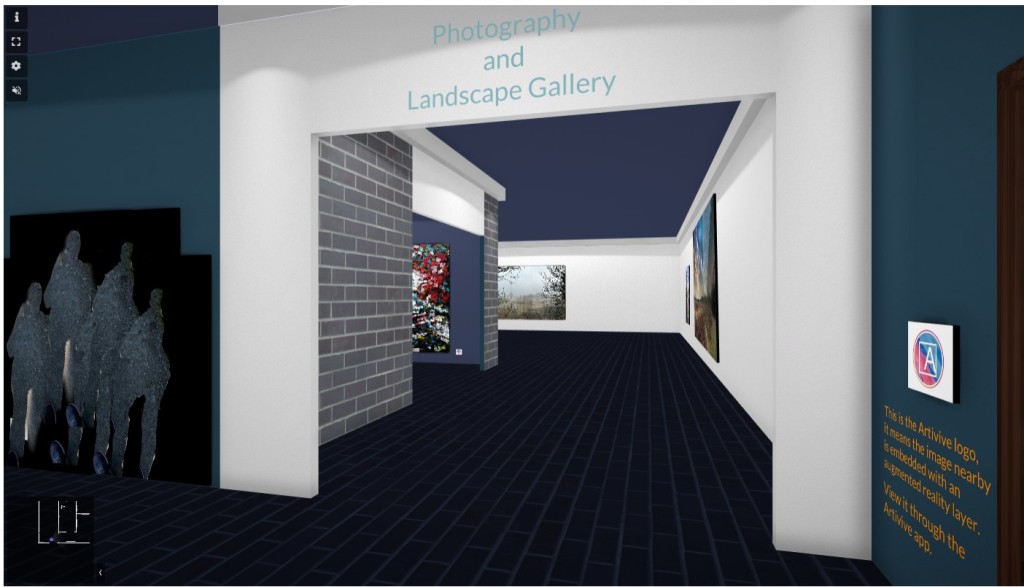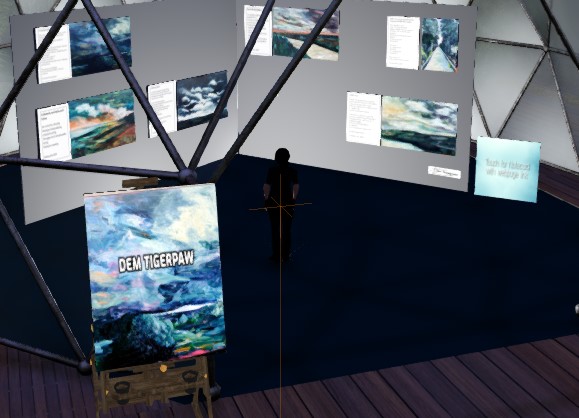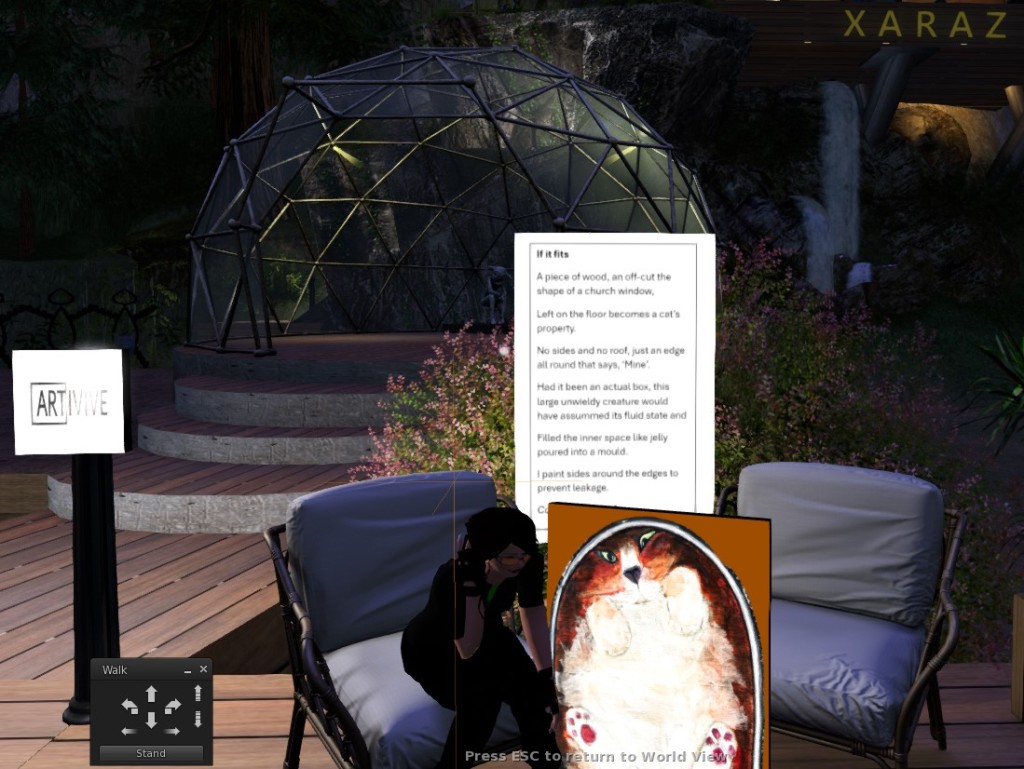The task
One of our goals towards the end of this nine year (yes, NINE year) course is to hold an exhibition of our work and in the process, to develop plans and strategies towards locating and negotiating space and dates, and meeting the owner’s requirements. Some of us will be old hands, others not at all. But most, given the average age of OCA students, will have experience of planning of some kind.
Still, this is different because you are inviting yourself into someone else’s business and asking them to take the risk your work will enhance rather than harm their reputation. Most require payment, not unreasonably.
For several reasons; including the availability of suitable venues in a semi-rural environment, and a few physical issues that are collectively rather than individually restricting; my options are limited, but I have sourced alternatives.
The process
I wrote in my earlier essay (Conboy-Hill, 2023) about the mental/cognitive process underpinning my approach to creativity, and it applies also to planning. Much of this happens in my unconscious – the Default Brain [Mode] Network – where all my experiences of planning, and any information I may have encountered regarding a new application of it are stored. I don’t need to think about it. In fact actively thinking about it is likely to disrupt the process, so I leave it to bubble away until it’s needed. I’ve come to trust the efficacy of this way of realising abstract and unformed ideas and, on cue, it emerged as a barely perceptible whole when the need arose.
Although ‘whole’ isn’t, well, the whole story. What emerges tends to be a timely scatter of action breadcrumbs, each with threads of dependent actions fixed beneath it. I can feel the weight of these so I know they’re not empty guesses, and because they are timely, they’re linked to an event, an experience, an opportunity.
For me, the opportunity came with the discovery of Artsteps, a virtual gallery environment for which you can either buy a template or build yourself at no cost. I began with a self-build which was my first experience of very basic 3D modeling. The architecture was ridiculous but it worked and I learned how to upload and install images, how to label them, how to find things I’d somehow lost through the ceiling or a wall, and how to ensure that items that should be on a surface, were not floating several metres in front of it.

I already had some experience of manipulating layers in a 3D space through Artivive which requires the application of an augmented reality (AR) layer to an image of a physical one using their bridge platform. This gave me a head start, as did the helpful linear outlining of walls in Artsteps and the easy placement of doors.
I have since built a second gallery for a peer group show (now taken down and restructured), and later purchased a template gallery which, while offering an upstairs feature, is disappointingly inflexible regarding lighting and colour scheme. Recently I added a much more carefully thought out ‘wing’ to my first effort.
Each enterprise has built on previous ones and each now cross-informs the others.
What happened next
I began considering a virtual venue that had passing traffic, as it were. Some people will know of Second Life, a massive user-led virtual world that is underpinned by gaming technology such as Havok but has no gaming elements. Residents are free to go where they please, engage in activities or not as they wish, and to build on any land they’ve bought or rented from another resident or Linden Labs.
Linden Labs is the originator of Second Life (SL) which went live in 2002 (see History of Second Life), and fully online in 2003, rapidly accruing over a million users or residents. And while elements of the press liked to focus on the often barely discernable clothing the women, of whom a good 40% were reported to be men, chose to wear, people with disabilities found a place where they could meet friends, go dancing, ride horses and swim without the need for a carer to be present. Universities such as Imperial College, London and the Open University had a presence there, as did some high profile organisations such as NASA which is still there. Viability remains an active disability centre in SL and in 2009, they helped our team with a research project involving adults with intellectual disabilities. The study, with partners at Brighton University and Imperial College, was published in the Journal of Medical Internet Research in 2011.
So I have form with this totally bonkers environment and, while finding my SL feet again has been a challenge, I thought if I could locate a gallery there, I might be able to put on a show that would be guaranteed to get that passing traffic. I put out a call on the Second Life forums board and within a few hours, I had a contact.
What has followed would be familiar to any artist seeking gallery space. Discussions about timings, numbers of pieces, when and for how long. I was particularly interested in how AR would work in VR and direction towards my OCA blog showed the gallery owner both the kind of work I was doing and how I saw the place of AR. The Artsteps gallery, on the other hand, I hoped would demonstrate my attention to curation and the kind of space in which I like to see my work. Nitty gritty stuff.
I was offered a space for six pieces from the 1st of May, but in the meantime I had access to a house a little way from the gallery to put some work – the cats in fact – and this was when I realised I would need to build. In all my time in VR environments I had never built anything and now I would need to figure out frames for the paintings before I could begin getting them to sit flush with the walls.
Veyot (in-world name, pronounced Vey Ott) is the owner of Xaraz gallery and has shown herself to be an absolutely superb support in all these matters. Every conversation follows the kind of track I would expect of any gallery owner – what should go where, which looks best, how about a white-board background here? Brightly lit or more subdued for these pieces? And the best possible advice – you don’t need to buy frames, you just make them from a cube. It took me a while but now I can knock off a backing piece, support if you like, in minutes.
Over the next few days, I ‘hung’ paintings in the basement of the gallery with Veyot popping in late afternoon my time, mid-morning hers, to see how things were going and to reclaim items for me that I’d lost through the walls. Her interest in the art and the curation were palpable, as was her skill at building. There are videos in this post, made in the gallery. Veyot built everything you will see there and quite a bit more.
As the landscape exhibition settled in, Veyot asked if I could bring the cat paintings to put upstairs on the deck. And now you see another advantage of SL where large items don’t have to be hefted from one place to another, and it doesn’t rain on them when you leave them out overnight.
This means I have two distinct exhibitions – cats on the deck outside where the passing traffic arrives via the landmark, and landscapes in the dignified surroundings of a formal gallery environment. In night mode, the deck looks remarkable (see video below).
Learning points
Building.
At this point, I was leaning paintings against railings in that casual street-art manner but realised this wouldn’t help the AR so went back to set them all upright. Each image is accompanied by a ‘tombstone’, a descriptive label of maximum 75 words. In these, I’ve chosen to extemporise in semi-poetic text that relates to some aspect of the painting or the subject. While I don’t claim to be writing actual poetry, and anyone who does will see immediately that it isn’t, there are Haikus here and there.
One of the other less ordinary features of this exhibition is its importation of AR targets. All these pieces can be activated using the Artivive app and I wanted to see if this would work in the VR environment. I doubt this has ever been done before and it was something that intrigued Veyot too, to the extent of wanting to keep it under wraps until we had it all set up. I can’t imagine that the physics underpinning the task of mapping an AR layer built in one space onto a VR environment that works on the principle of recreating mild impact effects are not in some sort of conflict at times. But, Dear Reader, it works! Admittedly a little frisky but no more so than with the outdoor installations I’ve set up. My theory is that viewer position is a determining factor and I’d imagine the etiquette of a physical gallery and the available space is likely to favour only one or two viewers at a time aiming their smart devices at a given painting, which may not be the case outdoors. In the street or an underpass there is room for many more people to try and only a few will find the sweet spot. Once we get into virtuality, many of the usual bets are off because nothing can be seen as stable or tangible; viewers can approach from any angle, there is built-in allowance for mobility in-world of almost everything, the pixels making up any given visual experience constantly shift with view-point, and don’t get me started on atoms. But see below:
In–app recordings
Aside from the mechanics of movement in SL and some of the rudimentaries such as instant messaging, redirecting communications to an email address, and setting up visitor counters so that they’re invisible and also don’t trip people up, I have experienced working with someone who really cares about their gallery and the work that appears in it. A person who is keen to have a formal opening and to give me a ‘stage’ to talk to people about the work, and who maintains clear business-like boundaries with no hidden agenda*. I have also purchased and subsequently broken an in-world powerpoint projector and will have to buy another. The slides though, made from an actual powerpoint converted to jpeg internet format which saves them as numbered slides, are not lost.
I have been visiting daily to adjust the positioning of the work and to check the visitor lists. I have looked at the venue from all angles, including up in the sky, an opportunity not available to many artists! Veyot sometimes asks for a change and sometimes I do – it’s a collaboration although I take care never to forget that this is her property.
I have also visited other SL galleries, partly to see what goes on in this environment but also to check out the price range for sales. These are in Linden dollars which are exchangeable for real world currency, the current rate being 1L$ to GBP 0.0025. [Yes, that is the right number of zeros in all the right places]. The work I saw was pitched somewhere between 75L$ and a couple of thousand, but most were around 800L$ and so this is where mine are sitting. For that, the purchaser is entitled to take a copy but neither the SL original nor the physical original is affected. they can hang their copies in their own property which could be a house, a boat, a dance club, or somewhere in their garden. My work, made from an Object which has its own individual status in-world, is stamped with my in-world name and doesn’t allow editing or further copies.
14th May. Veyot has been at work putting in a new floor and moving all the paintings upstairs where they’re on the same level as the outdoor pieces. I think this is good psychology and, due to the visitor counters, based on evidence. People are not keen on leaving a social environment to go somewhere else when they can’t be sure what that something else is even when travelling is not as effortful here as it might be in the real world (IRL). The downstairs area is also very much smaller than the deck.
This is where the landscapes are now, in an indoor space on the top floor of the building near the informal space of the deck where the cats are located.


‘Presence’
Everything that happens here relies on a phenomenon described by Jeremy Bailenson in an undated Futures interview as presence, “the term psychologists use to define that magic experience of when VR is a really compelling illusion … When VR is done well, you don’t even know you’re in VR – you’re just having an experience.” (See also Oh et al, 2018). There is an anecdotal tale about one of the researchers inviting Mark Zuckerberg to ‘cross the bridge’ in their VR lab. The bridge is an entirely virtual construction and Zuckerberg, along with the researchers themselves who had also tried this, knew exactly how it worked. So he put on the headset. The scene in front of him changed from the floor of the lab to a deep, deep chasm over which stretched a plank. And here is the power of VR and presence – he crawled across on hands and knees.
Second Life doesn’t require headsets and, in that, it is far more accessible. So is it less immersive, less present? It seems not, although arguably no one is afraid of jumping off cliffs, and the participant in our study who fell off the pier into the sea found it hilarious. He still related to it though in the collective first person, saying, “We’d better get out of here before the sharks get us!”
SL is a world with glaring imperfections; many of them due to people making avatars that are far taller than any human could be and with legs that go on forever. But a good many are due to the software itself which renders many of SLs elements as visually primitive. So why does it work? It works because its users choose to suspend disbelief and buy into the people behind/within the avatars.
Next steps
Both of the galleries in SL are requesting talks which I need to think through and structure. Many of the likely attendees are artists in both SL and the real world and, since travel is not an issue, could be from anywhere in the real world. Because of this, many talks are given at 12MD SL time which is also California time and seems to suit most people. It is 8pm in the UK.
I have since acquired an SL projector and loaded it with my slides, but I haven’t figured out yet how to stop other people from operating it as the lock doesn’t seem to work and it remains clickable by anyone at all, which could make for a chaotic presentation!
Update: I have broken this and had to buy a replacement.
Full circle
A casual conversation with our local pharmacist unexpectedly resulted in a physical exhibition opportunity when it transpired that the half-completed building between the river bank and the shops and houses on the high street is to be a rehearsal room which will have down-time between productions. We talked about exhibition space. He likes the idea. I have sent him a link to my Artsteps gallery.
Physical art, rendered digital with AR layers, hanging in a virtual gallery with limited foot traffic, provides a portfolio enabling representation at a gallery in a very social virtual environment, which leads to speaking engagements in both. And the experience of thinking about exhibitions; of curating, negotiating, and hanging work; and having discussions with people invested in their galleries has given me the grounding that made it possible to talk with someone in the real world about the same things.
SCH 2024
All elements copyright Suzanne Conboy-Hill
References
Conboy-Hill, S. (2023). Doors to Inception. Unpublished essay in part fulfilment of course requirements.
Hall, V., Conboy-Hill, S., Taylor, D. (2011). Using Virtual Reality to Provide Health Care Information to People With Intellectual Disabilities: Acceptability, Usability, and Potential Utility. Journal of Medical Internet Research, Vol 13, No 4
Oh, C., Bailenson, J., and Welch, G. (2018). A Systematic Review of Social Presence: Definition, Antecedents, and Implications. SYSTEMATIC REVIEW article, Front. Robot. AI, 15 October 2018, Virtual Environments, Volume 5 – 2018 | https://doi.org/10.3389/frobt.2018.00114
Interview with Jeremy Bailenson (undated). Immersive Virtual Experiences. Futures, Episode #8 https://futurespodcast.net/episodes/08-jeremybailenson. Presence can also apply to non-human avatars, and there are plenty of those, so long as they behave like humans. A box that behaves like a human will be accepted as such, whereas a human that behaves like a box will not. [my words drawn from similar research]
Conboy-Hill, S. & Taylor, D. ‘Virtual Worlds in Healthcare’. Live, in-world transmission to the Virtual Worlds global conference, 14th September, 2010.
